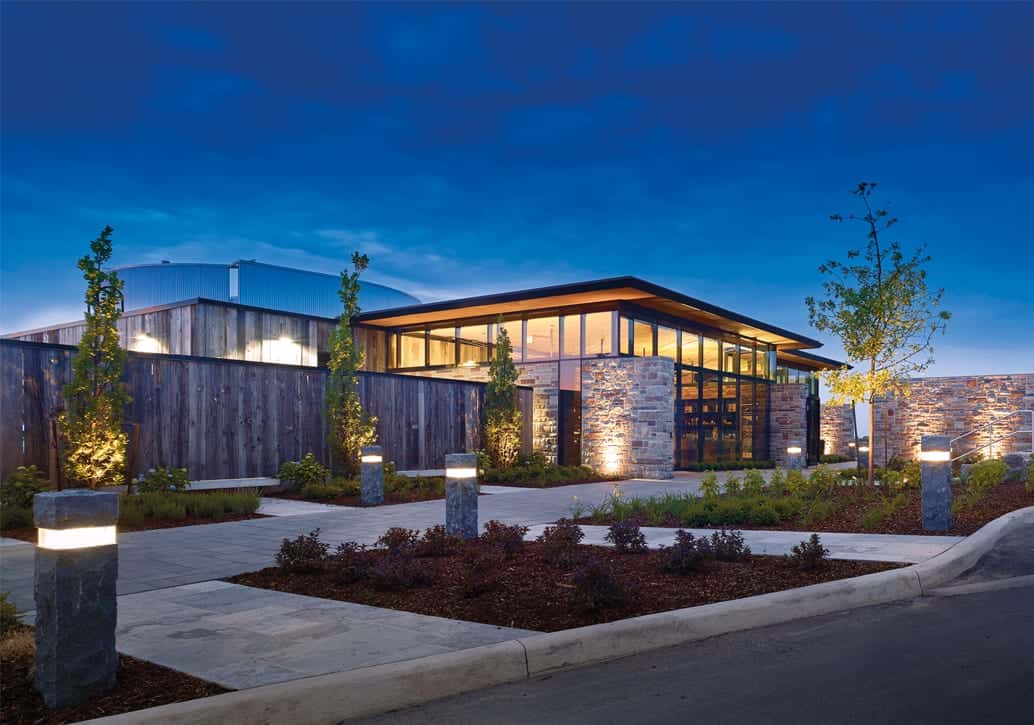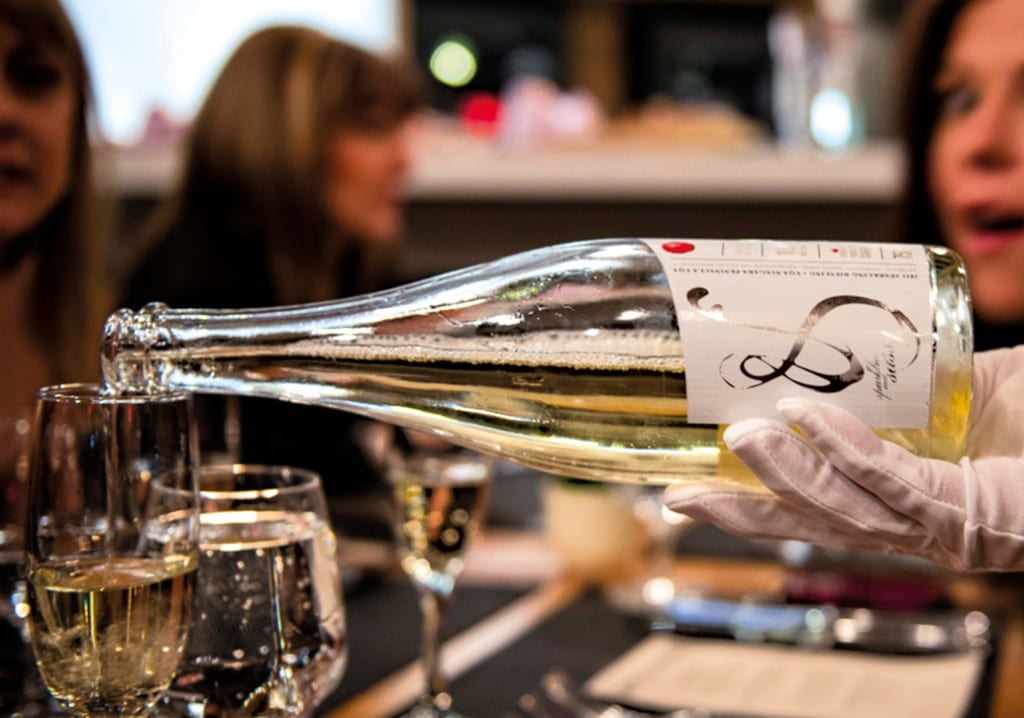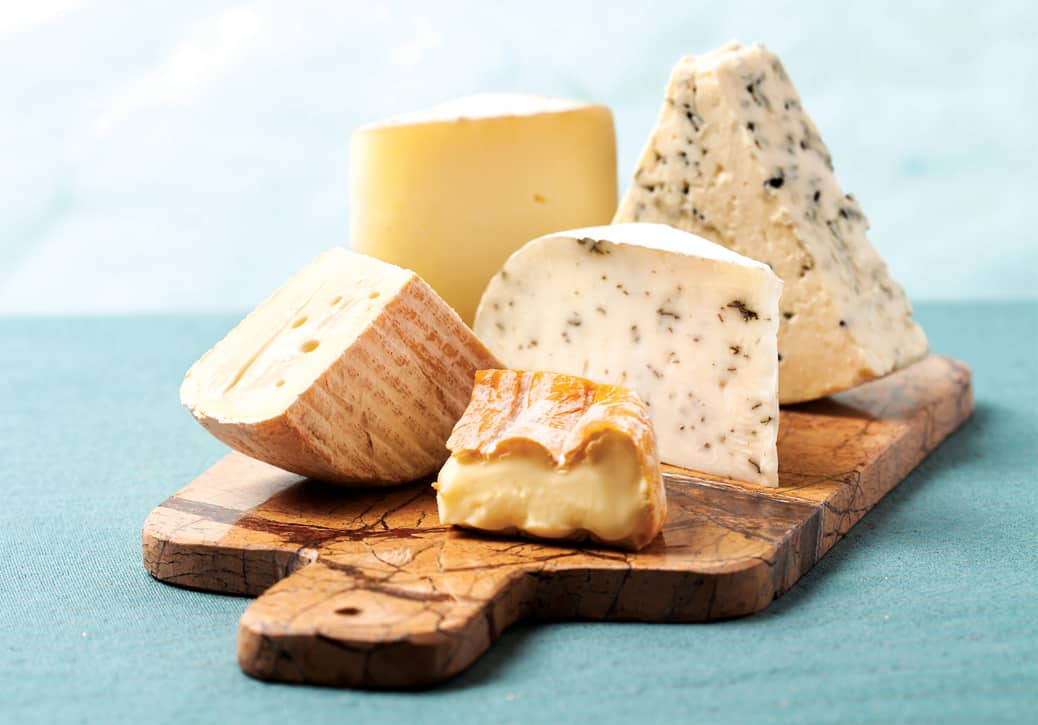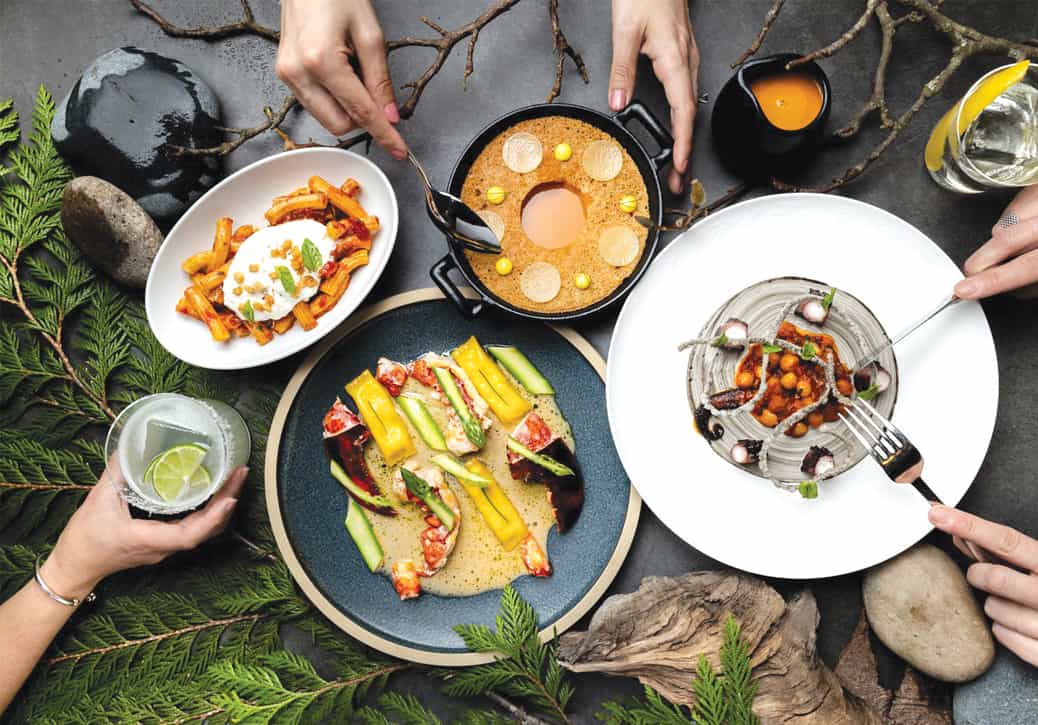A day in the Twenty Valley
It’s a prematurely cool late-summer day and my friends and I decide to leave “the six” and try our luck at exploring the very varied delights of the Twenty Valley, a less well-known part of Ontario’s wine country, near Beamsville.
 Pearl Morissette Estate Winery
Pearl Morissette Estate Winery
Our first winery stop is marked by a striking red cockerel sculpture at the end of a nondescript gravel driveway. Could this be the place? No sign. But then, I recall, visiting is a well-kept secret, by appointment only.
François Morissette has always trodden a different path. His, it turns out, is a truly bio-diverse farm where peach and apple orchards share space with grape vines. We chuckle as we’re told to watch out for the wandering ruminants and geese. Around us there’s an eclectic assortment of old and new buildings, most of which are painted black—a not-so-subtle allusion to Morissette’s long fight with the LCBO and the VQA who, in 2010, 2012 and 2014, rejected his critically acclaimed Riesling as atypical. They’ve playfully christened the wine Black Ball Riesling.
General manager Milton Mednick tells us that Morissette’s philosophy is to let the grapes express the terroir with minimal intervention, which means the winery concentrates on Chardonnay, Pinot Noir and Cabernet Franc, which are particularly suited to the region. In addition, their philosophy of natural wine-making using native yeasts and eschewing sulphur is in place wherever possible.
We had hoped to pick up some of Pearl Morissette’s fabulous 2013 Chardonnay Cuvée Dix-Neuvième (see Meandering—Fall 2017) but, perhaps not surprisingly, it is sold out. The 2014 is fine but with a very different taste profile. What impresses the most is a J.P. 2012 Chardonnay with a complex evolving depth. A case goes into the trunk!
Winemaker Brent Rowland allows me to barrel taste a 2015 Cabernet Franc. For such a young wine it is already remarkable and boasting a fine balance. I make a mental note to look out for this wine when it is released in a year or two.
Given its small production, Pearl Morissette has, so far, focused on supplying top restaurants in Canada, the USA, Hong Kong and Germany. However, the winery is planning to turn its old tractor barn into a restaurant, which suggests that it might become more consumer-focused as the years roll by.
Redstone
cows here. The striking ultra-modern, angular, stone-and-glass structure, home to the winery’s tasting room and restaurant, is visually arresting but curiously harmonious with its surroundings. Moray Tawse founded Redstone in 2007, as a small estate winery of just 32 acres. It also shares a vineyard with Tawse Winery on 19th Street. Redstone produced its first vintage in 2010 and opened its tasting room in 2015.
We sample a lovely 2012 Chardonnay, but what really stands out is a quite exceptional Sauvignon Blanc Semillon blend from 2012. Into the car goes another case—a mix that includes a stunning 2010 Cabernet Franc Ice Wine.
Exploring the building, we run into Tawse and winemaker Paul Pender sitting at the bar of the site’s light and airy restaurant. After trying a few more blends, it seems appropriate to stop here for a light lunch. It was a bit too cool for the patio but the restaurant, with its huge windows and wood and stone elements, is charming. It quickly fills up and we soon find out why. Our lunch is wonderful, and a glass of Redstone sparkling wine is a perfect companion. Attention to detail is evident in everything from the sourdough bread with olive oil or butter flavoured with lavender leaves, to the corn soup with salad vegetables underneath. I settle for a tasty meat pizza, which has a delightfully zingy finish.
The Foreign Affair Winery
The name conjures up an exotic, even risqué image. Curiously, we find a huge plaster Canadian Moose outside a nondescript building in what looks like an industrial park. But what Foreign Affair lacks in architectural flair, it makes up for with wine offerings that prove to be outstanding—thankfully, with prices to match.
At the top of the range, however, the appropriately named Unreasonable Cabernet Franc retails for a solid $163! We settle for some bottles of the more reasonably priced 2015 Dream Blend, a rich, bold and complex wine. The trunk is getting near to capacity. If we buy much more we may have to jettison a passenger.
Hidden Bench
The aptly named Hidden Bench, with its rustic-look building of stone and wood, is set deep in concealed folds of gentle hills. The business card on the counter tells us that Harald Thiel is the owner and vigneron. This suggests a hands-on approach to growing the grapes through to wine-making. With a string of awards under the winery’s belt, it’s clear that Thiel’s attention to every stage of the process has paid off. As luck would have it, hands-on vigneron Harald serves us.
He suggests we take our glasses out to the patio, where we order a charcuterie plate and sit in the recently arrived sunshine. The patio is warm and inviting, and we fall into pleasant banter with a small group from New York State. We could be in Europe, a few miles from the nearest town. Harald comes out with a sample of his yet to be released Natur Sparkling wine. It’s dry, but has a lovely floral intensity. We place an order for future delivery. In the meantime, he manages to find us a few bottles of the Pinot Noir we have tasted to fit into the car. This is going in the wine fridge for a while! The New Yorkers eventually wobble off on their bicycles and we move on to an adjacent winery.
The Organized Crime
A more improbably named winery would be difficult to find. We’re told it’s named after an odd squabble between two Mennonite sects over a pipe organ that resulted in its theft. We crunch down the drive to an unprepossessing house and find a wine-tasting room that appears to be the living room of someone who is overly infatuated with Rocco design themes. I’m smitten with the winery’s reds, and equally taken
by its remarkable floral and tropical fruit Gewürztraminer. We somehow find enough room for a mixed case.
Vineland Estates Winery
Our last stop, before the drive back to Toronto, is for dinner at Vineland Estates. Its striking stone buildings sit along a gentle, vine-covered hillside, dominated by an imposing Gothic-like clock tower. The dining room, in one of the lower buildings, has a stunning vista of the vineyards as they roll down the hill towards Lake Ontario. For better or worse, we can even catch a glimpse of Toronto on the horizon.
Chef Justin Downes’ light-touch tasting menu with locally sourced ingredients is tempting but, after all our earlier sampling and nibbling, we decide that a main course and dessert will be more than sufficient. I opt for the duck leg confit with totally indulgent fingerling potatoes in duck fat. But I also sample the Cumbrae skirt steak with roasted bone marrow. Each dish is artistically presented with well-balanced flavours. A home run for certain! With a bottle of Vineland Estates Chardonnay, the meal is a perfect ending to our wonderful wine-tasting tour in the Ontario countryside.
 Other Epicurist Favourites…
Other Epicurist Favourites…
Cumbrae’s
“That’s a leg, isn’t it?” a woman hesitantly asks, to no one in particular, as she gazes at the massive pieces of meat hanging in the window of Cumbrae’s, on Toronto’s Bayview Avenue. Stepping inside the company’s new, expanded location, I can’t miss the north wall—a temperature- and humidity-controlled dry aging case. It’s abundantly stocked with rows of first-class purplish tinged roasts tagged with their butchering dates.
Cumbrae’s actually has its own farm, purchased by third-generation Australian master butcher Stephen Alexander shortly after he arrived in Toronto in 1994. The shops sell only dry-aged beef from Cumbrae’s own farm and from similar local farms where animals are raised ethically and naturally. Dry aging has long been preferred by top chefs with healthy budgets who are looking for the best flavours and a firmer drier texture.
Here at Cumbrae’s, it seems you get what you pay for. You won’t find any anonymous, pink, wet-aged meat on polystyrene trays. Rather, you can talk to keen and knowledgeable staff behind the counter, backed up by an onsite team out the back, hacking, cutting and carving to fill the day’s orders.
Funnily enough, my visit to the Toronto’s newest butcher’s shop reminded me of an old-fashioned butcher’s near Nether Wallop (or was it Middle Wallop?) in England. It was here that I mischievously purchased a well-hung pheasant, feathers and all. My fiancée, soon to be my wife, was on nursing night duty at the hospital and, while she was gone, I plunked the whole bird down on her pillow. She returned and, after reflecting briefly on my sanity, gamely plucked and roasted it. At that moment, I knew that I had chosen wisely (with respect to my wife, not the pheasant.)
But I digress. Back to Cumbrae’s, where it’s not just about the raw cuts of meat. Browsing an exotic display of prepared food, I discover a 20-month-old Spanish serrano ham, smoked pancetta from Niagara and Berkshire prosciutto from Iowa. Next to them is world-class olive oils, porcini shallot butter and “ready to heat and serve” pies. Most intriguing is an Aussie pie of ground beef, pork and red wine. Further along, there are ready-to-cook pouches of beef stroganoff, butter chicken, and steak and bean chilli. Oh, and have I mentioned artisanal cheeses, including the Lindsay Bandaged Goat cheese from, of course, Lindsay, Ontario?
Those who are pressed for time can grab a hot meal ready to be popped into to-go containers or tasty oversized sandwiches to be had at the food counter.
Cumbrae’s seems to have thought of everything I need, including a way to circumvent the parking challenges on Bayview. Customers can phone an order ahead and call from the car just before they arrive, so that the butcher can run out front with your order. It’s not just the beef that’s treated humanely.
The Food Lab (a book by J. Kenji López-Alt)
Buying the finest ingredients does not guarantee chef-quality results. Cookbooks are, as pointed out by the authors, notoriously vague over crucial things. A pinch of that? Cook at medium-high? Why is that meat overdone on the outside and raw inside? And let’s not get into the primal debate over whether or not to flip steaks on the barbeque. So thank our lucky stars that I recently stumbled upon on a hefty tome, The Food Lab: Better Home Cooking Through Science, which piqued my curiosity.
After a quick flip, I knew this was the cookbook for me. Yes, it has great recipes, but the showstopper is López-Alt’s in-depth lab-tested techniques and tool recommendations. Now I know that fried eggs need to be cooked at a specific temperature; that sealing a roast to prevent moisture loss is an old-wives’ tale; and (spoiler alert) that you should start barbequing your steak over low heat, flipping frequently until it reaches a certain temperature, then let it rest. Only then do you finish it off over high heat.
Other lessons learned: the specific “medium-rare beef” temperature, the difference between heat and temperature, and the importance of precision during various stages of cooking. To think I used to struggle to boil an egg.
Thermapen Mk4
The first item in the Food Lab’s list of essential small tools is an instant-read thermometer. I initially balked at the price of the recommended one, the Thermapen by ThermoWorks, but once I had used it, I was convinced. The Thermapen is incredibly fast and accurate to a tenth of a degree so, to my way of thinking, it’s money well spent for something that is head and shoulders above the competition. I also caved in and bought an infrared thermometer “gun” to measure the temperature of the pans I‘m cooking with. No more guessing.
 Homefront’s man about town is suave, debonair, charming and, best of all, extremely curious. He hunts, sleuths, discovers, explores and tells all.
Homefront’s man about town is suave, debonair, charming and, best of all, extremely curious. He hunts, sleuths, discovers, explores and tells all.












